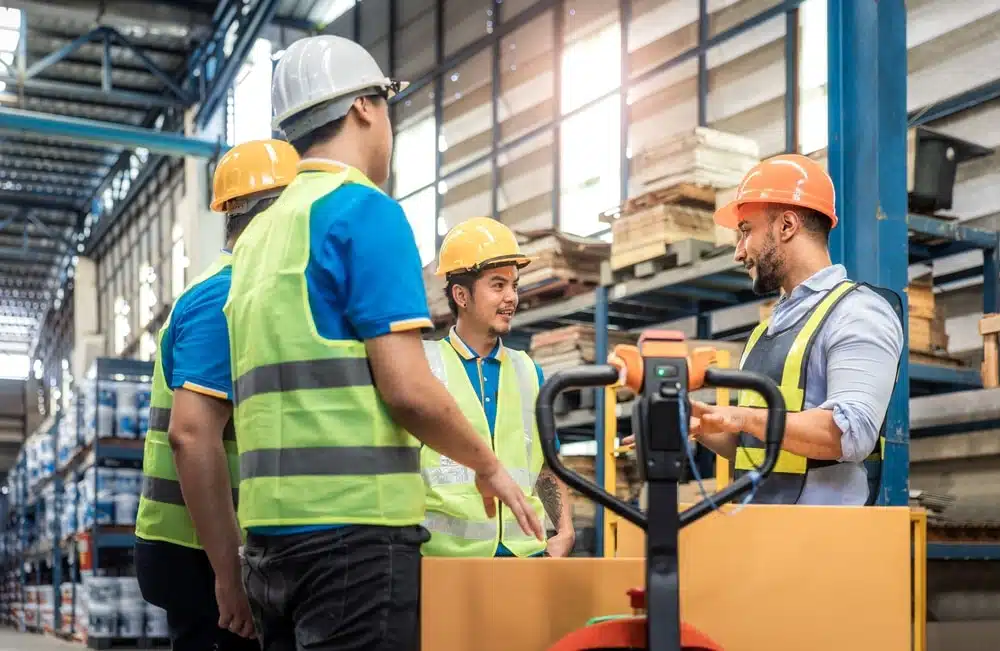
In the high-stakes world of warehousing, logistics, and supply chain management, ‘good enough’ just doesn’t cut it anymore. On any given day, you likely find yourself battling tight deadlines, rising customer expectations, and the relentless pressure to do more with less. In this challenging landscape, lean warehouse training emerges not just as a methodology, but as your secret weapon in the quest for unparalleled efficiency and competitiveness.
But what does it really take to implement lean principles in your warehouse operations? How can you ensure your team is not only trained in lean concepts but also fully equipped to apply them in day-to-day operations? This guide is designed to answer these questions and more. We’ll delve deep into the core principles of training for lean warehousing and offer practical insights and actionable strategies tailored to the unique challenges of your industry.
The Core of Lean Warehousing: Principles That Drive Success
Lean warehousing is more than a set of practices; it’s a philosophy that reshapes the entire landscape of warehouse operations. At its heart are principles focused on maximizing efficiency and minimizing waste. These are principles that when applied diligently, can lead to significant transformations in your operations.
Let’s explore these foundational concepts that are key to driving success in lean warehouse management:
Value from the Customer’s Perspective
The cornerstone of lean is understanding and delivering what your customers value most. Is it speed, accuracy, or reliability? By aligning your processes to these values, you ensure that every step in your warehouse adds real, tangible value, cutting out anything that doesn’t contribute.
Identifying and Eliminating Waste
In lean terminology, waste refers to anything that doesn’t add value. This could be excess inventory, unnecessary steps in a process, or even unproductive waiting times. By identifying and systematically eliminating these wastes, you not only streamline operations but also focus on reducing costs and unlocking significant savings.
Examples of lean strategies for waste reduction include Six Sigma and the 5S System. This is a methodology rooted in lean manufacturing but is equally effective in lean warehousing. 5S stands for Sort, Set in Order, Shine, Standardize, and Sustain.
Continuous Improvement (Kaizen)
Lean warehousing is a continuous journey, not a destination. The principle of Kaizen involves everyone in your organization in the pursuit of regular, incremental improvements. It’s about fostering a culture where every team member is always on the lookout for ways to enhance processes and increase efficiency.
Optimizing the Whole, Not Just the Parts
A key lean principle is to look at your operations holistically. Improvements in one area should not create inefficiencies in another. This approach ensures that the entire workflow is optimized, leading to more cohesive and efficient operations.
Empowering Employees
At its core, lean is about people. Empowering your workforce with the necessary training, tools, and decision-making authority is vital. When your team is actively involved in identifying issues and implementing solutions, the impact on your warehouse operations can be profound.
Pursuing Perfection
The lean journey is an ongoing pursuit of perfection. While achieving perfect order processing or 100% perfect orders may not be likely, the pursuit itself guides your operations towards excellence. It involves setting high standards, consistently measuring performance, and always seeking ways to improve.
Related: Lean Warehouse Management: Streamlining Operations and Enhancing Productivity

Customizing Your Lean Training Approach: Tailoring to Your Team’s Needs
The journey to lean excellence in your warehouse is unique, just like your team and your operational challenges. A one-size-fits-all approach to lean training simply won’t deliver the results you’re looking for.
That’s why customizing your lean training program is crucial to ensure it resonates with your team and aligns with your specific operational goals.
Here’s how you can develop a training program that not only educates but also inspires and empowers your team:
- Assessing Your Team’s Current Skill Level: Before diving into training, take a step back and assess the current skill level and lean knowledge of your team. Understanding where they stand helps in tailoring the training content to be both challenging and achievable.
- Setting Clear, Achievable Goals: What do you want to achieve with your lean training program? Is it reducing processing time, minimizing errors, or improving overall efficiency? Set clear, measurable goals that align with your broader operational objectives.
- Interactive and Engaging Training Methods: Lean training should be interactive, engaging, and, most importantly, practical. Consider incorporating hands-on workshops, simulations, and real-life case studies. This approach, especially in complex tasks like order picking, helps in translating theoretical knowledge into practical skills.
- Regular Feedback and Adaptation: Training is not a one-off event but an ongoing process. Regular feedback sessions help in understanding the effectiveness of the training and areas that need more focus. Be prepared to adapt the training program based on this feedback.
- Incorporating Technology and Tools: In today’s digital age, leveraging technology in training is essential. Utilize e-learning platforms, virtual simulations, and other digital tools to enhance the learning experience and make it more accessible.
- Creating a Supportive Learning Environment: Foster an environment where questions are encouraged, and mistakes are seen as learning opportunities. A supportive learning culture promotes continuous learning and improvement.
- Tracking Progress and Celebrating Successes: Keep track of the progress made through the training program. Celebrate the milestones and successes along the way. This not only motivates the team but also reinforces the value of the lean training program.
By customizing your lean training approach, you’re not just imparting knowledge; you’re building a team that’s equipped, motivated, and ready to drive lean principles in every aspect of your warehouse operations. In the next section, we’ll explore the critical role of technology, particularly Warehouse Management Systems (WMS), in supporting and enhancing your lean training efforts.
Leveraging Technology in Lean Training
When it comes to lean warehouse training, the right technology can help facilitate your transition to greater efficiency and precision. Understanding and integrating technology such as a Warehouse Management System (WMS) is crucial. Let’s look at some of the ways tech helps transform lean training from theory to practice:
Integrating WMS into Training
A Warehouse Management System is at the heart of modern warehousing operations. Incorporating WMS into your lean training allows your team to understand how technology can streamline processes, reduce errors, and optimize inventory management. Hands-on training with your WMS should be a key component of your program.
Simulating Real-World Scenarios
Advanced simulation tools can create virtual environments that mimic real-world warehouse challenges. These simulations can be used to train staff on how to apply lean principles in different scenarios, helping them to develop problem-solving skills in a risk-free setting.
Data-Driven Decision Making
Technology enables the collection and analysis of vast amounts of operational data. Training your team to interpret this data can lead to more informed decisions, aligning closely with lean principles of efficiency and continuous improvement.
E-Learning for Flexibility and Accessibility
E-learning platforms offer flexibility in training delivery, allowing team members to learn at their own pace and revisit complex topics as needed. This flexibility is crucial in a busy warehouse environment where taking time out for training can be challenging.
Augmented Reality (AR) for Enhanced Learning
AR technology can overlay digital information onto the real warehouse environment, providing an immersive learning experience. This can be particularly effective for complex tasks like equipment operation or spatial planning.
Mobile Technology for On-the-Go Learning
Mobile apps and tools allow team members to access training materials and resources on the go, fostering a culture of continuous learning and improvement.
Feedback and Analytics for Continuous Improvement
Technology can also play a key role in gathering feedback and providing analytics on the effectiveness of the training program. This data can be invaluable for refining the training process and ensuring it meets its objectives.

Implementation Challenges: Overcoming Obstacles in Lean Training
Implementing a lean warehouse training program can transform your operations, but it’s not without its challenges. Understanding the potential obstacles and coming up with strategies to overcome them is crucial for a successful transition to lean practices. Here’s a look at common challenges and practical tips for navigating them:
Resistance to Change
One of the biggest hurdles is often the resistance to change from employees. Overcoming this requires clear communication about the benefits of lean training, involving team members in the process, and providing reassurance and support throughout the transition.
Skill Gaps in the Workforce
Not all employees may have the same level of understanding or skill when it comes to lean principles. Address this by offering varied levels of training and creating mentorship programs where more experienced staff can guide others.
Aligning Lean Principles with Existing Processes
Integrating lean principles into existing workflows can be challenging. Start with small, manageable changes and gradually build up to more significant transformations. This incremental approach helps in better assimilation of lean practices.
Maintaining Consistency Across the Team
Ensuring that everyone is on the same page can be difficult, especially in larger teams. Regular meetings, updates, and refresher training sessions can help maintain consistency and keep everyone aligned with the lean objectives.
Measuring and Tracking Progress
Sometimes, the benefits of lean training may not be immediately visible. Establish clear metrics and KPIs to track progress and demonstrate the tangible benefits of the lean initiatives over time.
Balancing Lean Training with Day-to-Day Operations
Finding the time for training while keeping up with daily operational demands is a common challenge. Consider flexible training schedules, e-learning options, and on-the-job training methods to manage this balance.
Adapting to Technological Changes
As technology evolves, so must your lean training. Stay updated with the latest technological advancements and incorporate them into your training program to keep it relevant and effective.
By anticipating these challenges and preparing strategies to address them, you can ensure a smoother and more effective implementation of lean warehouse training.

Measuring Success: Evaluating the Impact of Your Lean Training Program
To ensure that your investment in lean warehouse training is yielding the desired results, it’s essential to have a robust system for measuring and evaluating its impact. This involves setting clear metrics and Key Performance Indicators (KPIs) that align with your operational goals. Here’s how you can effectively track and assess the success of your lean training program:
- Establishing Clear KPIs: Identify key performance indicators that are most relevant to your lean objectives. These could include metrics like inventory turnover rate, order fulfillment accuracy, processing time, and employee productivity.
- Baseline Measurement: Before implementing the lean training program, record baseline measurements of your chosen KPIs. This provides a reference point to compare against and assess improvements.
- Regular Monitoring and Reporting: Set up a system for regular monitoring and reporting of these KPIs. This ongoing evaluation helps in identifying trends, tracking progress, and making informed decisions.
- Employee Feedback and Engagement: Beyond quantitative metrics, employee feedback is invaluable. Regular surveys, interviews, and discussions with staff can provide insights into how the training has impacted their work and where further improvements can be made.
- Cost-Benefit Analysis: Evaluate the financial impact of the lean training program. Consider factors like cost savings from reduced waste, improved efficiency, and increased productivity against the investment made in the training.
- Continuous Improvement Process: Use the data and feedback gathered to continuously refine and improve your lean training program. This iterative process ensures that your training remains effective and relevant.
- Benchmarking Against Industry Standards: Compare your performance with industry benchmarks or standards. This can provide an external perspective on how your operations stack up against peers and where there is room for improvement.
By effectively measuring the success of your lean warehouse training program, you can ensure that it continues to drive efficiency and productivity in your operations.
The Future of Lean Training: Staying Ahead in a Changing Landscape
As the warehousing and logistics industry continues to evolve, staying ahead of the curve in lean training is crucial for maintaining a competitive edge. The future of lean training involves adapting to new technologies, methodologies, and market demands. Here’s what you need to consider to ensure your lean training program remains relevant and effective in the face of these changes:
- Embracing Technological Advancements: The future of warehousing is intertwined with technological innovation. From automation and robotics to AI and IoT, staying abreast of these advancements and incorporating them into your lean training will be key.
- Customized and Adaptive Learning: As each team member’s learning style and pace vary, the future of training lies in personalized learning experiences. Utilizing adaptive learning technologies can help tailor training to individual needs, enhancing effectiveness.
- Sustainability and Eco-Efficiency: With an increasing focus on sustainability, lean training will need to incorporate eco-efficient practices. Training on how to minimize environmental impact while maintaining efficiency will become increasingly important.
- Agility and Resilience Training: The ability to quickly adapt to market changes and disruptions is vital. Future lean training should focus on building agility and resilience within teams, preparing them for unexpected challenges.
- Data Literacy and Analytics: As decision-making becomes more data-driven, equipping your team with data literacy skills will be essential. Understanding how to analyze and use data effectively should be a core component of lean training.
- Continuous Learning Culture: The concept of continuous improvement in lean applies to training as well. Fostering a culture of continuous learning, where employees are encouraged to regularly update their skills and knowledge, will be crucial.
- Global and Cross-Cultural Competence: As businesses become more global, understanding and working effectively across different cultures and markets will be an important aspect of lean training.
- Remote and Virtual Training Capabilities: The rise of remote work and digital collaboration tools means that lean training programs must also adapt to support remote learning and virtual teamwork.
By anticipating these future trends and incorporating them into your lean training strategy, you can ensure that your team remains equipped and ready to meet the challenges of tomorrow’s warehousing landscape. This proactive approach will not only keep your operations efficient but also position your business as a forward-thinking leader in the industry.
Conclusion: Streamlining Your Path to Excellence with Lean Training
In summary, lean warehouse training is more than a set of techniques; it’s a transformative journey towards operational excellence. By embracing lean principles, you’re not just streamlining processes, but you’re also building a resilient, efficient, and future-ready warehousing operation. The key lies in commitment to continuous improvement, adaptability to change, and a focus on empowering your team.
The benefits of this journey are clear: enhanced efficiency, cost savings, improved employee engagement, and superior customer satisfaction. As you navigate this path, remember that the goal is to foster a culture of excellence and innovation, positioning your warehouse as a leader in the industry.
Ready to take your warehouse operations to the next level?
Find out how our software can help facilitate lean operations in your warehouse so that you can achieve operational excellence. Contact us today to learn more and start your journey towards a leaner, more efficient future.



